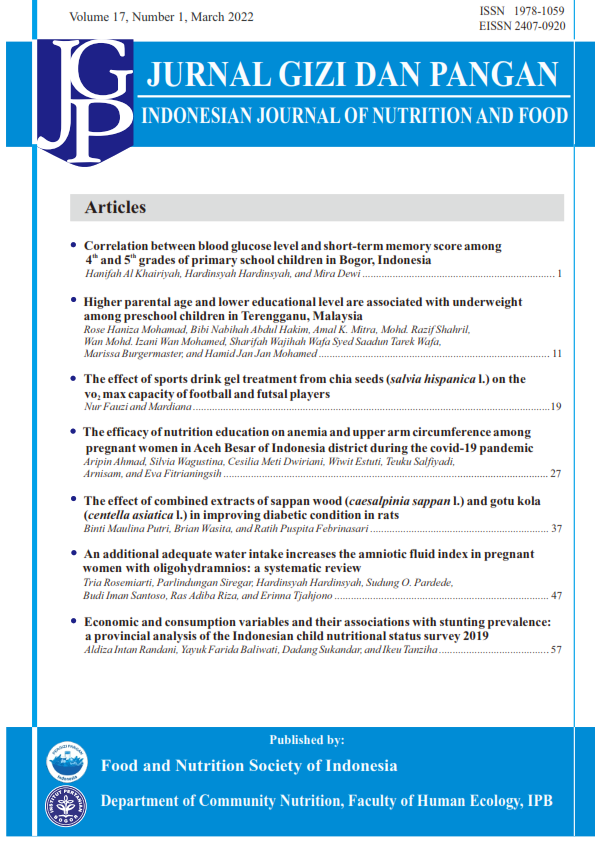Higher Parental Age and Lower Educational Level are Associated with Underweight among Preschool Children in Terengganu, Malaysia
Abstract
This cross-sectional study aimed to investigate the determinants of underweight among preschool children. A total of 218 preschool children were enrolled. Their sociodemographic data were collected using self-reported questionnaires whilst body weight and height were measured, recorded and the BMI for-age z-score was calculated using WHO AnthroPlus software. Of all preschool children participants, 47.7% were male and 53.3% were female. Most of them were Malays (99.5%), aged 4 to <5 years (40.8%) and came from low-income household (92.7%). Overall, the prevalence of underweight, normal, overweight and obese was 17.9%, 73.8%, 4.6% and 3.7% respectively. The underweight prevalence was higher than the national prevalence (13.7%). Of all parent participants, 12.4% were male and 87.6% were female. Most of them aged 30−39 years (55.5%) and did not hold a degree (89.4%). Multivariate logistic regression showed that parental age and their level of education were the determinants of childhood underweight. The risk of being underweight increased with the age of parents (p=0.033) and lower level of education of parents (p=0.042). In conclusion, this study found that underweight among preschool children was mainly associated with parental factors. Hence, designing a special nutritional intervention program involving older parents and lower education levels could overcome this problem.
References
Abu Bakar N. 2016. Play Pedagogy in Malaysia. Terengganu (KL): Universiti Sultan Zainal Abidin.
Arifin WN. 2013. Introduction to sample size calculation. Education in Medicine Journal 5(2):89−96. https://doi.org/10.5959/eimj.v5i2.130
Baharudin A, Man CS, Ahmad MH, Wong NI, Salleh R, RAdzi MRM, Ahmad NA, Aris T. 2019. Associated factors to prevalence of childhood undernutrition in Malaysia: Findings from the National Health and Morbidity Survey (NHMS 2016). Health Sci J 13(1):1−9. https://doi.org/10.21767/1791-809X.1000627
Bowden D, Hicks N, Shippen M. 2013. Southeast Asia: A Region Revealed. Oxford (UK): John Beaufoy Publishing Limited.
Campoy C, Campos D, Cerdó T, Diéguez E, García-Santos JA. 2018. Complementary feeding in developed countries: The 3 Ws (When, what, and why?). Ann Nutr Metab 73:27−36. https://doi.org/10.1159/000490086
Chowdhury MRK, Rahman MS, Khan MMH, Mondal MNI, Rahman MM, Billah B. 2016. Risk factors for child malnutrition in Bangladesh: A multilevel analysis of a nationwide population-based survey. The J Pediatr 172:194−201. https://doi.org/10.1016/j.jpeds.2016.01.023
Department of Statistics Malaysia. 2020. Household income & basic amenities survey report 2019. https://www.dosm.gov.my/v1/index.php?r=column/rev&id=TU00TmRh1N5TUxHVWN0T2VjbXJYZz09 [Accessed 10th December 2020].
Huiracocha-Tutiven L, Orellana-Paucar A, Abril-Ulloa V, Huiracocha-Tutiven M, Palacios-Santana G, Blume S. 2019. Child development and nutritional status in ecuador. Glob Pediatr Health 6:2333794X18821946.
Katzmarzyk PT, Barreira TV, Broyles ST, Champagne CM, Chaput JP, Fogelholm M, Hu G, Johnson WD, Kuriyan R, Kurpad A et al. 2013. The international study of childhood obesity, lifestyle and the environment (ISCOLE): Design and methods. BMC Public Health 13(1):1−13. https://doi.org/10.1186/1471-2458-13-900
Khambalia AZ, Lim SS, Gill T, Bulgiba AM. 2012. Prevalence and sociodemographic factors of malnutrition among children in Malaysia. Food Nutr Bull 33(1):31−42. https://doi.org/10.1177/156482651203300103
Khattak UK, Iqbal SP, Ghazanfar H. 2017. The role of parents' literacy in malnutrition of children under the age of five years in a semi-urban community of pakistan: A case-control study. Cureus 9(6):e1316. https://doi.org/10.7759/cureus.1316
Lee ST, Wong JE, Chan GK, Poh BK. 2021. Association between compliance with movement behavior guidelines and obesity among Malaysian preschoolers. Int J Environ Res Public Health 18(9):4611. https://doi.org/10.3390/ijerph18094611
Mak K, Tan SH. 2012. Underweight problems in Asian children and adolescents. Eur J Pediatr 171(5):779−785. https://doi.org/10.1007/s00431-012-1685-9
Martins VJ, Toledo Florêncio TMM, Grillo LP, Do Carmo PF, Martins PA, Clemente APG, Sawaya AL. 2011. Long lasting effects of undernutrition. Int J Environ Res Public Health 8(6):1817−1846. https://doi.org/10.3390/ijerph8061817
Menalu MM, Bayleyegn AD, Tizazu MA, Amare NS. 2021. Assessment of prevalence and factors associated with malnutrition among under-five children in Debre Berhan Town, Ethiopia. Int J Gen Med 14:1683−1697. https://doi.org/10.2147/IJGM.S307026
[NHMS] National Health and Morbidity Survey. 2016. National Health and Morbidity Survey 2016: Maternal and Child Health. Kuala Lumpur (KL): Institute for Public Health, National Institutes of Health, Ministry of Health Malaysia.
[NHMS] National Health and Morbidity Survey. 2019. National Health and Morbidity Survey Vol. I: NCDs—Non-Communicable Diseases: Risk Factors and Other Health Problems. Kuala Lumpur (KL): Institute for Public Health, National Institutes of Health, Ministry of Health Malaysia.
Naing L, Winn TBRN, Rusli BN. 2006. Practical issues in calculating the sample size for prevalence study. Arch Orofac Sci 1:9−14.
Noraida O, Norhasmah S, Barakatun-Nisak MY. 2017. Factors related to any-breastfeeding duration in a sample of Malay mothers. IJPHCS 4(1):133−141.
Norimah AK, Mohd nasir MT, Hazizi AS, Surya I, Loh S, Nurliyana AR. 2014. Association of body weight status and socio-demographic factors with food habits among preschool children in Peninsular Malaysia. Malays J Nutr 20(3):303−315.
Owoo NS, Lambon-Quayefio MP. 2021. Mixed methods exploration of Ghanaian women's domestic work, childcare and effects on their mental health. PLoS ONE 16(2):p.e0245059. https://doi.org/10.1371/journal.pone.0245059
Salleh NW, Hamid SB, Nor NM, Shuhaimi FA, Zaman MK, Ismail NH. 2021. Diet quality and growth status of children aged two to six years at Tuba Island, Langkawi, Malaysia. J Gizi Pangan 16(3):159−168. https://doi.org/10.25182/jgp.2021.16.3.159-168
Tosheno D, Mehretie Adinew Y, Thangavel T, Bitew Workie S. 2017. Risk factors of underweight in children aged 6−59 months in Ethiopia. J Nutr Metab. https://doi.org/10.1155/2017/6368746
Vollmer RL, Baietto J. 2017. Practices and preferences: Exploring the relationships between food-related parenting practices and child food preferences for high fat and/or sugar foods, fruits, and vegetables. Appetite 113:134−140. https://doi.org/10.1016/j.appet.2017.02.019
Vollmer RL. 2019. Parental feeding style changes the relationships between children's food preferences and food parenting practices: The case for comprehensive food parenting interventions by pediatric healthcare professionals. J Spec Pediatr Nurs 24(1):e12230. https://doi.org/10.1111/jspn.12230
[WHO] World Health Organization. 2019. Growth reference data for 5−19 years. https://www.who.int/tools/growth-reference-data-for-5to19-years/application-tools [Accessed 1st December 2019].
[WHO] World Health Organization. 2021. Malnutrition. https://www.who.int/health-topics/malnutrition#tab=tab_1 [Accessed 10th October 2021].
Authors

This work is licensed under a Creative Commons Attribution-ShareAlike 4.0 International License.





